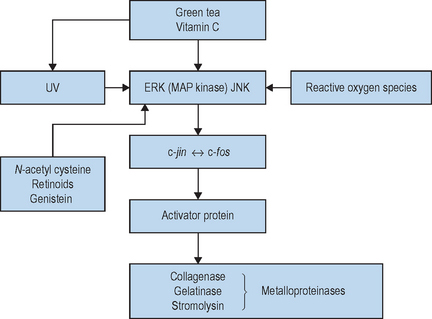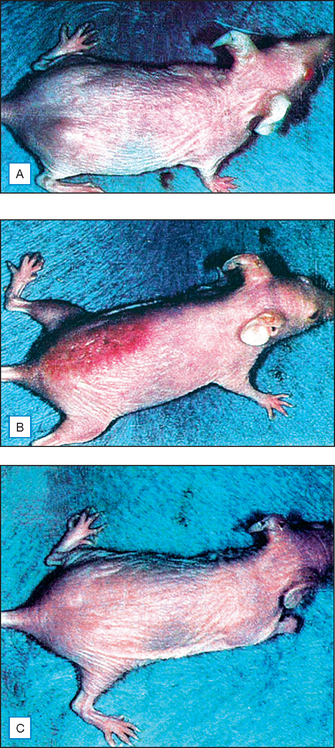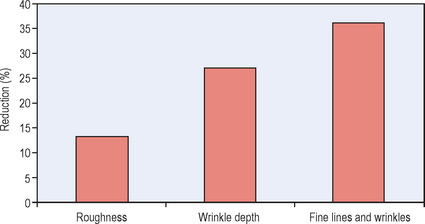Chapter 32 Future Cosmeceuticals of Dermatologic Importance
ANTIOXIDANTS
Our skin is continuously exposed to oxidative stress leading to accelerated aging by damaging DNA, lipids, and proteins. Various endogenous antioxidant systems are designed to protect us from these oxidative stresses. Oxidative stress results from many sources including genetics, environmental factors, and ultraviolet (UV) radiation. The action mechanism of antioxidants in induction is such that they prevent free radicals from forming chain reactions that have the capability of damaging cells during oxidation of other molecules. Antioxidants are comprised of various molecules such as alpha lipoic acid (ALA), coenzyme Q-10, polyphenols, idebenone, kinetin, and vitamins A, B, C, and E. Antioxidants are widely used as treatments in many human diseases and have now become a vital source in cosmeceuticals because of their strong photoprotective effects, thereby resulting in reduction of erythema, sunburn cell formation, DNA changes, and carcinogenesis Fig. 32.1.
GENISTEIN
Although numerous in vitro studies have shown its potential in anticancer properties, evidence is lacking on its effect on skin carcinogenesis, but there is scientific support for its potential. Genistein has been found to have chemopreventive and strong anticancer activities. It has been shown to inhibit the activity of tyrosine protein kinase (TPK), topoisomerase II (Topo II), and ribosomal S6 kinase (RS6K) in cell culture. It has also been shown to inhibit growth of the ras oncogene and decrease PD6F-induced c-fos and c-jun expression in fibroblasts. Experiments were conducted to prove that genistein substantially blocks subacute and chronic UVB- and PUVA-induced cutaneous damage (Box 32.1; Figs 32.2 and 32.3).
IDEBENONE
Idebenone, a newly developed antioxidant, is based on sunburn assays, photochemiluminescence, primary and secondary oxidative product assays, and evaluation of damage to UVB-irradiated keratinocytes. Idebenone is a powerful antioxidant outperforming many others. It has the capability of penetrating deep into the dermal layer of the skin and destroying free radicals associated with exposure to UV radiation. A five-part study to measure the environmental protection factor (EPF) and the safety and efficacy of idebenone was conducted. For each part of the study the highest possible score was 20 points for a total of 100. Idebenone was rated 95 out of 100 points in improvement of fine lines and wrinkles, radiance, dry and photodamaged skin, and elasticity (Table 32.1).
GLOBAL REJUVENATION AGENTS
• Vitis vinifera
In one study comparing a serum and a cream versus a serum, both of which contained the Vitis vinifera shoot extract (grape seed), 26 subjects used the serum twice a day for 28 days and 30 subjects used the serum and cream twice a day for the same time period. The treatment area was the face and neck. Improvement in firmness, radiant glow, softness, texture, fine lines and wrinkles were tracked. There was no significant difference in findings between the serum and cream and the serum group. Fifty-four percent of the serum-treated subjects noted an overall global improvement greater than 25% (using a quartile scale) while 60% of the serum and cream group noted equal improvement.
• Peptides
Peptides serve as messenger vehicles between the dermal and epidermal layers of the skin, enabling efficient communication between cells. In a number of peptide studies conducted to test their efficacy in cosmeceuticals, the most effective proved to be pal-pentapeptide (pal-KTTKS), composed of lysine, threonine, threonine, lysine, and serine. It has been used in combination with palmitic acid for enhanced penetration into the skin for stimulation of cellular growth of collagen and fibronectin synthesis. A 4-month study was conducted with applications of twice-daily medication on the face and neck. Results showed a decrease in roughness of the skin by 13%, reduction in fine lines and wrinkles by 36%, and a decrease in wrinkle depth by 27%. Pal-KTTKS increases elastin fibers and regulation of collagen IV at the skin junction Fig. 32.4.
CONCLUSION
In addition to the high efficacy of antioxidants, such as polyphenols and coffeeberry, which aid in the prevention of many human diseases and in the alleviation of photoaging of skin, the future generation of cosmeceuticals focuses on global rejuvenation. This new approach to skin care centers on the reversal of aging.
Akiyama T, Ishida J, Nakagawa S, et al. Genistein, a specific inhibitor of tyrosine-specific protein kinases. Journal of Biological Chemistry. 1987;262:5592–5595.
Albertazzi P, Pansini F, Bonaccorsi G, et al. The effect of dietary soy supplementation on hot flushes. Obstetrics and Gynecology. 1998;91:6–11.
Arora A, Nair MG, Strasburg GM. Antioxidant activities of isoflavones and their biological activities in a liposomal system. Archives of Biochemistry and Biophysics. 1998;356:133–141.
Brzezinski A, Adlercreutz H, Shaoul R, et al. Short-term effects of phytoestrogen-rich diet on postmenopausal women. Menopause. 1997;42:89–94.
Cai Q, Wei H. Effects of dietary genistein on antioxidant enzyme activities in Sencar mice. Nutrition and Cancer. 1996;25:1–7.
Correa P. Epidemiological correlations between diet and cancer frequency. Cancer Research. 1981;41:3685–3690.
Cornacchione S, Neveu M, Talbourdet S, et al. In vivo skin antioxidant effect of a new combination based on a specific Vitis vinifera shoot extract and a biotechnological extract. Journal of Drugs in Dermatology. 2007;6:S8-S18.
Draelos Z. Botanical antioxidants. Cosmetic Dermatology. 2003;16:46–48.
Fotsis T, Pepper M, Adlercreutz H, et al. Genistein, a dietary-derived inhibitor of in vitro angiogenesis. Proceedings of the National Academy of Sciences USA. 1993;90:2690–2694.
Gyorgy P, Murata K, Ikehata H. Antioxidants isolated from fermented soybeans (tempeh). Nature. 1964;203:870–872.
Kang S, Chung JH, Lee JH, et al. Topical N-acetyl cysteine and genistein prevent ultraviolet-light-induced signaling that leads to photoaging in human skin in vivo. Journal of Investigative Dermatology. 2003;120:835–841.
Kapiotis S, Hermann M, Held I, et al. Genistein, the dietary-derived angiogenesis inhibitor, prevents LDL oxidation and protects endothelial cells from damage by atherogenic LDL. Arteriosclerosis, Thrombosis and Vascular Biology. 1997;17:2868–2874.
Kiguchi K, Constantinou A, Huberman E. Genistein induced cell differentiation and protein-linked DNA strand breakage in human melanoma cells. Cancer Communications. 1990;2:271–278.
Lambert JD, Hong J, Yang G, et al. Inhibition of carcinogenesis by polyphenols: evidence from laboratory investigations. American Journal of Clinical Nutrition. 2005;81(Suppl):284S-291S.
Lee EH, Cho SY, Kim SJ, et al. Ginsenoside F1 protects human HaCaT keratinocytes from ultraviolet-B induced apoptosis by maintaining constant levels of Bcl-2. Journal of Investigative Dermatology. 2003;121:607–613.
Li D, Yee JA, McGuire MH, Yan F. Soybean isoflavones reduce experimental metastasis in mice. Journal of Nutrition. 1999;29:1075–1078.
Manach C, Scalbert A, Morand D, et al. Polyphenols: food sources and bioavailability. American Journal of Clinical Nutrition. 2004;79:727–747.
Messina M, Barnes S. The role of soy products in reducing risk of cancer. Journal of the National Cancer Institute. 1991;83:541–546.
Monon LG, Kuttan R, Nail MG. Effect of isoflavone genistein and daidzein in the inhibition of lung metastasis in mice induced by B16F-10 melanoma cells. Nutrition and Cancer. 1998;30:74–77.
Okura A, Arakawa H, Oka H, Yoshinari T, Monden Y. Effect of genistein on topoisomerase activity and on the growth of [VAL 12] Ha-ras-transformed NIH 3T3 cells. Biochemical and Biophysical Research Communications. 1988;157:183–189.
Pinnell SR. Cutaneous photodamage, oxidative stress and topical antioxidant protection. Journal of the American Academy of Dermatology. 2003;48:1–19.
Pratt DE, Di Pietro C, Porter WL, Giffee JW. Phenolic antioxidants of soy protein hydrolyzates. Journal of Food Science. 1981;47:24–25.
Scalbert A, Williamson G. Dietary intake and bioavailability of polyphenols. Journal of Nutrition. 2000;130:2073S-2085S.
Tham DM. Potential health benefits of dietary phytoestrogens: a review of the clinical, epidemiological and mechanistic evidence. Journal of Clinical Endocrinology and Metabolism. 1998;83:2223–2235.
Wang Y, Yaping E, Zhang X, et al. Inhibition of ultraviolet B induced c-fos and c-jun expression by genistein through a protein tyrosine kinase-dependent pathway. Carcinogenesis. 1998;19:649–654.
Wei H, Bowen R, Zhang X, Lebwohl M. Isoflavone genistein inhibits the initiation and promotion of two-stage skin carcinogenesis. Carcinogenesis. 1998;19:1509–1514.
Wei H, Cai Q, Rhan R. Inhibition of Fenton reaction and UV light-induced oxidative DNA damage by soybean isoflavone genistein. Carcinogenesis. 1996;17:73–77.
Yamaguchi M, Goa YH. Genistein inhibits bone loss. Biochemical Pharmacology. 1998;55:71-76.
Yao-Ping L, You-Rong L, Jian-Guo X, et al. Topical applications of caffeine or (–)-epigallocatechin gallate (EGCG) inhibit carcinogenesis and selectively increase apoptosis in UVB-induced skin tumors in mice. Proceedings of the National Academy of Sciences USA. 2002;99:12455–12460.
Zwiller J, Sassone-Corsi P, Kakazu K, Boyton AL. Inhibition of PDGF-induced c-jun and c-fos expression by a tyrosine protein kinase inhibitor. Oncogene. 1991;6:219–221.












